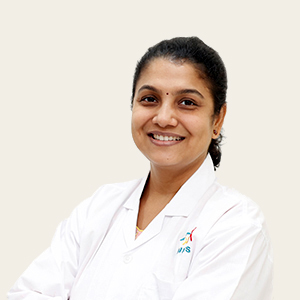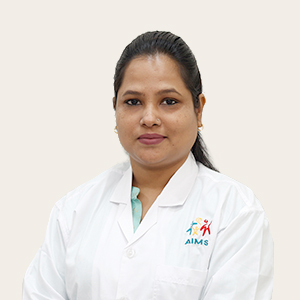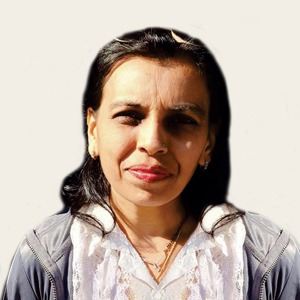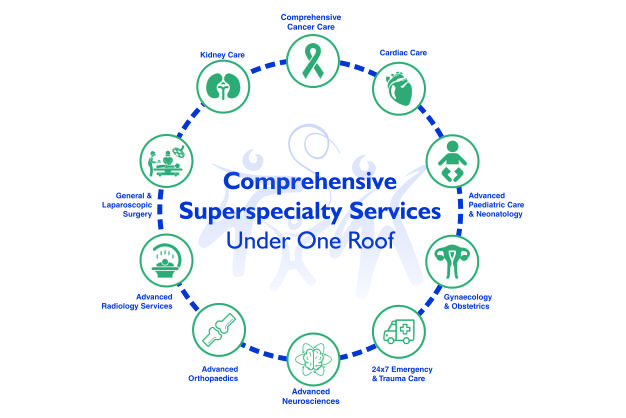Overview
The Department of Obstetrics and Gynaecology offers a broad spectrum of women's health care services involving unborn children and pregnant women along with efficient management of related diseases. The department also renders state-of-the-art technologies with superlative care providing a full range of healthcare services such as painless deliveries, minimally invasive surgeries, management of high-risk pregnancies/late pregnancies. AIMS provides expert gynecological and obstetric treatment along with specialist services for special disease groups.
AIMS ensures the total safety and comfort of women patients as well as their children. The team performs procedures that are completely safe and are well tested. The department also focuses on expert counseling and quality care on matters related to family welfare, menopause management, prenatal diagnosis, reconstructive surgery, and pelvic floor medicine.
The Centre offers a host of facilities to ensure high-quality antenatal care to treatment for expectant mothers, new mothers, and babies. The Centre deals with the entire spectrum from preconception planning to pregnancy care, childbirth, and postpartum care, thus ensuring the safest possible conception, pregnancy, delivery, and post-delivery care.
Services Offered
Obstetric Services:
- Contraceptive measures
- Medical Termination of Pregnancy
- Reproductive endocrinology (hormonal defects)
- Infertility Management
- Pain management for labour and delivery
- Comprehensive pre-natal care: Prenatal checkups,complete maternal and fetal monitoring, exclusive laboursuites,Full time team of obstetricians, anaesthetists&nenonatologists, 24 hour surgical capability and anesthesia support , immediate access to Neonatal ICU, etc.
- High risk pregnancy including diabetes in pregnancy, pre-eclampsia and hypertensive disorder, previous or recurrent pregnancy loss, preterm labor and delivery, pregnancy with cardiac and any medical disorder.
- Multidisciplinary care if needed in associated cardiac, mental, renal and general medical problems.
- Multi-disciplinary care for co management of high risk pregnancies with endocrinologist, physician, anesthetist, ultrasonologist, etc.
Gynecological Services:
- Management of dysfunctional uterine bleeding and other menstrual disorders
- Management of polycystic ovarian disease (PCOD), fibroids and endometriosis
- Minimally invasive hysterectomy (removal of uterus)
- Laparoscopic assisted tubal anastomosis, reversal of tubectomy, ligation/sterilization and diagnosis and treatment of ectopic pregnancy
- Screening for cervical cancers and surgery for cancers of the female reproductive system
- Uro-gynaecology
- Evaluation and management of endocrine disorders (eg: prolactin, thyroid).
Laparoscopic Surgery
Laparoscopic Gynecologic Surgery procedures
Almost all surgeries that were formerly done by open surgery are nowadays being performed laparoscopically.
- Diagnostic Hystero- Laparoscopy is a safe procedure to look inside the abdomen and pelvis to diagnose conditions related to the ovaries, uterus, and fallopian tubes. It is a common procedure used in the management of infertility and chronic pelvic pain
- Laparoscopic Ovarian drilling is a surgical treatment to trigger ovulation in women who have polycystic ovarian syndrome where weight loss and medication haven’t worked
- Ovarian Cystectomy is done for a cyst, which is fluid-filled sacs, in the ovaries
- Laparoscopy for ectopic pregnancy is when the embryo implants itself anywhere other than in the womb. Laparoscopy is done even for ruptured ectopic pregnancy with significant blood loss, which can be life-threatening
- Laparoscopy for diagnosis and treatment of mild to moderate endometriosis, which is a condition in which the tissue lining the uterus, grows outside the uterus on the ovaries, bowel, or anywhere else in the abdominal cavity
- Laparoscopic hysterectomy (removal of the uterus) for all sizes of uterus up to 30 cms size, as heavy as 2-3 kgs, even for patients with previous cesarean sections & previous multiple surgeries
- Laparoscopic oophorectomy is the removal of the ovaries
- Laparoscopic myomectomy is done for the removal of fibroids
- Laparoscopic tubal recanalization is done for women who want to conceive after tubectomy. Also done for clearing tubal obstruction to enable conception
- Laparoscopic surgeries during pregnancy
- Laparoscopy for staging and treatment of gynecological malignancies
Hysteroscopy
What is Hysteroscopy?
This is a procedure that enables your doctor to look inside the uterus in order to diagnose and treat causes of abnormal bleeding, using a special instrument called a hysteroscope. This is a thin, lighted tube that is inserted into the vagina to examine the cervix and inside of the uterus. The hysteroscope transmits images of the uterus onto a screen. The difference between laparoscopy and hysteroscopy is that the former is able to view outside the uterus and the latter visualizes inside the uterus and fallopian tubes. A hysteroscopy may be done along with a laparoscopy or a dilatation and curettage. It is generally done under local, regional or general anesthesia.
Hysteroscopy is normally done after a period prior to expected time of ovulation
Diagnostic Hysteroscopy:
Hysteroscopy is done for diagnostic purposes including taking samples of tissue for a biopsy. It is also used to confirm results of other tests like hysterosalpingography, which is a dye test to check the uterus and fallopian tubes. It may also be done to find the cause of severe cramping or repeated miscarriages.
Therapeutic Hysteroscopy:
This is done to treat the condition detected during a diagnostic hysteroscopy. Hysteroscopy is done for the following:
- Fibroid removal
- Polyps removal
- Septal resection is the removal of a congenital septum inside the uterus
- Endometrial resection for abnormal bleeding, where endometrial ablation is done with a hysteroscope to destroy the endometrium
- Cannulation for proximal tubal block
- Removal of Copper T which cannot be removed through the cervix
- Adhesiolysis is done for adhesions also called Asherman’s syndrome, which are bands of scar tissue inside the uterus, which can cause infertility and problems with menstrual flow
Benefits of Hysteroscopy:
- Quicker recovery
- Shorter hospital stay
- Less medication required after surgery
- Avoiding open surgery or hysterectomy
Technology & Infrastructure
- State of the art Endoscopic theatre with 3D Cameras, Monitors and ancillary equipment’s.
- High Tech Labor room with birthing chair
- Operating Hysteroscopes , Versapoint, Harmonic ultrasound Ligasure vessel sealing devices, Latest Unipolar and Bipolar coagulation colposcope
- High risk pregnancy for continuous foetal Monitors
- Epidural Anesthesia for painless delivery
- Baby friendly nursing care with lactation management
Specialists

DR. DEEPALI LODH
GYNAECOLOGIST & OBSTETRICIAN
M.B.B.S., D.N.B. (OBS & GYNAEC)
View details
Appointment

DR. SHRUTI KOTANGALE
GYNAECOLOGIST & OBSTETRICIAN
M.S. (Obs & Gyn), D.N.B. (OBGY), F.M.A.S, F.A.R.T.
View details
Appointment

DR. MONA RANA YADAV
GYNAECOLOGIST & OBSTETRICIAN
MD (Gyn& obs)
View details
Appointment
ABOUT US
About AIMSDirector's Message
Vision & Mission
Accreditations
Awards & Accolades
Our Network
Phone Directory
Designed by Web Creations 2022. All rights reserved.










